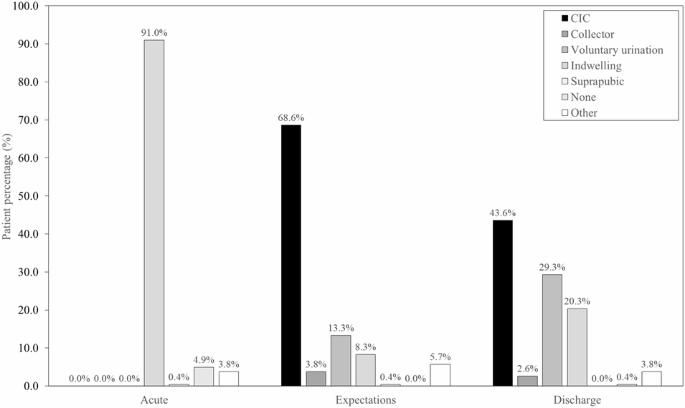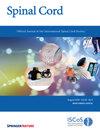脊髓损伤病房从入院到出院的神经源性膀胱管理监测:SIRCA研究
IF 2.2
4区 医学
Q3 CLINICAL NEUROLOGY
引用次数: 0
摘要
研究设计:前瞻性、描述性、分析性、观察性研究,涉及来自西班牙和意大利的12个多中心国际中心。目的:探讨不同内在因素和环境因素下脊髓损伤患者膀胱排尿的方法。神经源性膀胱在脊髓损伤(SCI)患者中很常见,严重影响其生活质量。清洁间歇导尿(CIC)是首选的方法,因为较少的并发症和感染,提高了生活质量,其他方法,如留置导尿或避孕套导尿是膀胱管理的可行选择。方法:收集急性期(入院时)、亚急性期(出院时)和出院期的数据。结果:收集了266例SCI患者的数据。入院时膀胱排尿的主要方式为留置导尿(n = 242, 91.0%),出院时使用最多的方式为CIC (n = 122, 45.9%)。在进行出院期望评估时,CIC是首选程序(n = 181, 68.6%)。随着美国脊髓损伤协会(ASIA)损伤量表评分的提高,出院时反射性排尿的概率更高(p)。结论:神经源性膀胱管理在水平和损伤严重程度、SCIM、BMI、婚姻状况、年龄和抑郁史等方面存在差异。赞助:B布劳恩医疗有限公司本文章由计算机程序翻译,如有差异,请以英文原文为准。

Monitoring of neurogenic bladder management from hospital admission until discharge in spinal cord injury units: the SIRCA study
Prospective, descriptive, analytical, observational study involving 12 multicenter, international centers from Spain and Italy. Determine the method for bladder voiding in spinal cord injury (SCI) patients concerning different intrinsic and environmental variables. Neurogenic bladder is common in spinal cord injury (SCI) patients, profoundly impacting their quality of life. While clean intermittent catheterization (CIC) is the preferred method due to fewer complications and infections and improved quality of life, alternative methods like indwelling catheterization or condom catheters are viable options for bladder management. Data was gathered along the acute (at hospital admission), subacute (expectations at discharge) and hospital discharge phases. Data from 266 SCI patients was gathered. Main procedure for bladder voiding at the time of admission was indwelling catheterization (n = 242, 91.0%) and CIC was the most used procedure at discharge (n = 122, 45.9%). CIC is the preferred procedure when the evaluation of expectations at discharge is done (n = 181, 68.6%). The probability of achieving reflex voiding at discharge was higher as the American Spinal Injury Association (ASIA) Impairment Scale score improved (p < 0.001). A relationship was established with the level of injury (p < 0.001) and body mass index (p = 0.017), in addition to marital status, age and history of depression. Initial information about CIC was mostly provided by the urologist (n = 137, 73.3%) while training was predominantly done by the nurse (n = 159, 87.8%). Differences in neurogenic bladder management were identified regarding level and injury severity, SCIM, BMI, marital status, age and depression history. B Braun Medical S.A.U.
求助全文
通过发布文献求助,成功后即可免费获取论文全文。
去求助
来源期刊

Spinal cord
医学-临床神经学
CiteScore
4.50
自引率
9.10%
发文量
142
审稿时长
2 months
期刊介绍:
Spinal Cord is a specialised, international journal that has been publishing spinal cord related manuscripts since 1963. It appears monthly, online and in print, and accepts contributions on spinal cord anatomy, physiology, management of injury and disease, and the quality of life and life circumstances of people with a spinal cord injury. Spinal Cord is multi-disciplinary and publishes contributions across the entire spectrum of research ranging from basic science to applied clinical research. It focuses on high quality original research, systematic reviews and narrative reviews.
Spinal Cord''s sister journal Spinal Cord Series and Cases: Clinical Management in Spinal Cord Disorders publishes high quality case reports, small case series, pilot and retrospective studies perspectives, Pulse survey articles, Point-couterpoint articles, correspondences and book reviews. It specialises in material that addresses all aspects of life for persons with spinal cord injuries or disorders. For more information, please see the aims and scope of Spinal Cord Series and Cases.
 求助内容:
求助内容: 应助结果提醒方式:
应助结果提醒方式:


